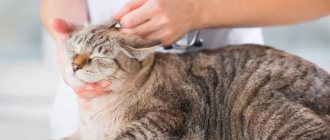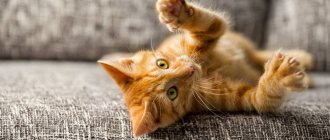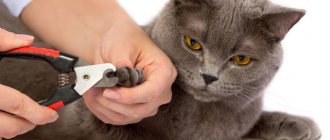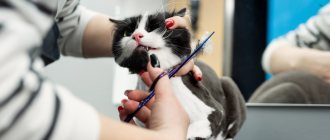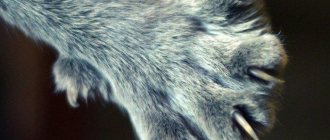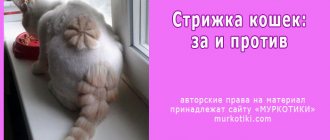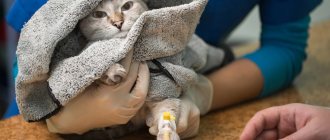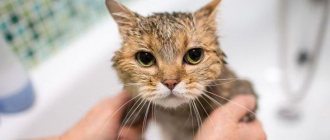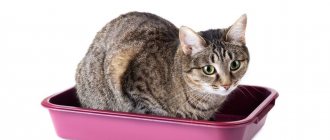By bringing a small fluffy kitten into our home, we take responsibility for its health. In addition to proper feeding, vaccinations, and grooming, ear cleaning should become a regular procedure. This is necessary in order to prevent ear diseases, which cause suffering in pets and take a long time to treat. Questions about how to clean a kitten’s ears, whether it is necessary to do this if the ear is clean, arise often. It all depends on the pet’s lifestyle, the breed, and even the size of the ears.
How often to clean your ears
Whether a cat’s ears need to be cleaned can only be determined after a careful examination. It is advisable to do it daily. You should make it a rule that when your pet sits comfortably on your lap, look into its ears. If there are no dark deposits, stains, dots or scratches, no cleaning is required. Clean ears that do not bother the cat can be cleaned once every few months as a preventive measure.
Your cat's ears need to be cleaned if:
- dirt, dusty deposits;
- spots, dots or bumps that are black or brown;
- dry dark crusts;
- excess sulfur, purulent discharge;
- scratches, dried blood;
- unpleasant odor from the ear canal.
It is also necessary to cleanse if the cat shakes its head and constantly scratches its head behind the ears.
Ears should be examined daily and cleaned as soon as they become dirty.
General recommendations
Kittens are given away at the age of two to three months.
In the article about the character of the Scottish Fold cat, I already noted that representatives of this breed are very freedom-loving and value personal space. Therefore, it is its arrangement that, first of all, should be given maximum attention. This area should contain items to meet minimal needs: bowls for food and water, toilet, sleeping place, toys.
Otherwise, caring for fold ears does not cause any particular difficulties. To prevent the coat from matting, it is enough to brush it once or twice a week. Periodically (once a week or two) you need to inspect the eyes of your Scottish Fold and wash them with water or a special liquid. Things are somewhat more complicated with the ears, since this is the most problematic area for lop-eared people. Ear care should be correct and regular.
What you need to clean your ears
Many cats do not like the cleansing procedure; they may break out, scratch, hiss, and even bite. It is best to teach it from an early age, as cleaning a kitten’s ears is not difficult. A kitten whose ears have been cleaned since childhood, slowly and without sudden movements, has no fear of such a procedure. Some pets even like it, they close their eyes and lie quietly.
For stubborn adult animals, it is best to wrap them in a large towel or thin blanket. It is important that the cat does not have the opportunity to pull out its paws. This way you will not only make cleaning easy, but also protect yourself from deep scratches.
What you need for cleaning:
- cotton pads (sponges), they can be replaced with soft cotton cloth;
- cotton buds;
- a special lotion or gel for cleaning, which can be purchased at a veterinary pharmacy.
Since cleaning a cat’s ears at home sometimes needs to be done urgently, a special lotion can be replaced with vegetable oil or warm boiled water.
You should know that any cleanser is applied to a cotton pad. Under no circumstances should you drip it into a cat's ears.
Arrangement of the place and “personal” things of the fold
Any Scottish Fold cat should have at least three bowls. Two are for food, and one is for water. The material from which the vessels are made may vary. But I would recommend giving preference to ceramic or metal bowls. Firstly, such dishes are much easier to wash. Secondly, these materials are the safest; they do not contain any chemical compounds that could enter your pet’s body.
The Scots have a real passion for toys, so there should be a lot of them. There are several ways to provide leisure time for kittens. Educational games are most suitable for this breed. They like toys with springs or rustling/rattling/clanging balls that they have to run after. You can keep your cat occupied for a long time with toys attached to a string, which she can swing with her paw and catch. Having these toys in childhood and staying physically active significantly reduces the risk of many diseases later in life.
Don't forget about the scratching post too. Any, absolutely any, cat needs to sharpen its claws. You can buy a ready-made scratching post at a pet store, or you can make one from scrap materials. Cardboard, carpet or sisal are perfect for the base. It is better to place the scratching post in the area where other toys are located, since it is during the period of maximum physical activity that animals feel the need for it. If you don’t provide a place for sharpening claws, be prepared for the pet to start doing mischief: peeling wallpaper, scratching furniture, ruining curtains. To avoid this, encourage your pet to use the scratching post more often: praise him, show him how to use it.
Rules for cleaning ears
To carry out hygiene measures you do not have to run after your pet throughout the house, pull it out from under the bed or remove it from the closet, before the procedure you should play with it a little or caress it. Everything you need must be prepared in advance. In order to calm a cat, it is enough to stroke it and talk in a calm, quiet voice. Prepare your favorite treat. A small piece can be given in advance.
How to properly clean your ears:
- wrap your pet in a thin blanket;
- Gently bend the ear outward so that all the curves of the inner part become visible. It doesn't hurt cats;
- soak a cotton pad or soft cloth in the cleanser and lightly wipe the entire inside of the ear;
- if there is a lot of dirt, then you should take a clean disk and repeat the cleansing;
- The cotton swab should also be moistened and all bends should be thoroughly cleaned. If necessary, the procedure should be repeated.
It is a myth that a pet's eardrum can burst. In cats, there is a bend in the ear, and it is impossible to reach the eardrum with a stick. The only thing that can cause harm is scratching the thin skin if the stick is very hard or if you clean it carelessly.
It is important to carry out all cleaning movements from the inside out, otherwise you can push dirt inside the ear canal, which can cause an inflammatory disease.
Features of caring for fold-eared cats
Fold cat ears are cleaned in the same way as any other pet. The nuance is that such breeds are not able to wash the “locators” themselves due to the unusual structure of the auricle. More frequent inspection and close attention will be required.
Proceed as usual. To begin, turn the ear outward (as it should be when properly cleaning a cat’s ears) and use a flashlight to illuminate the ear canal. Be careful - cats' cartilage is very delicate. If you notice plaque and dirt, remove it as you would a regular cat.
After the procedure, you will have to thoroughly dry the folded ear, because excess moisture can lead to diaper rash and the rapid formation of diseases.
When dirt in the ears is an indicator of disease
Sometimes dirty ears are an indicator of a disease. Contacting a veterinary clinic may be required if:
- ears get dirty within a few days after hygiene procedures;
- a lot of wax is produced in the ear canal;
- purulent discharge does not stop;
- At the same time, the cat is restless, itches often, leaving scratches, and shakes its head.
Such symptoms occur with otitis media of any severity or when the ear canal is damaged by ear mites. Accurate diagnosis is carried out in a veterinary clinic. The earlier treatment is started, the more effective it is, and the less the animal suffers.
If left untreated, your pet may experience deafness. In addition, the ear contains the vestibular apparatus, which is responsible for balance. If your cat has ear diseases, he or she may experience dizziness and nausea.
Drops are used to treat ear diseases. In some cases, the veterinarian may prescribe antibacterial and anti-inflammatory drugs.
It is necessary to instill the medicine only after removing purulent discharge and sulfur, otherwise the effect of the drug will not be effective. The cleansing procedure is carried out in the same way as for healthy cats, but instead of a special cleansing gel, the doctor may recommend hydrogen peroxide or chlorhexidine. After recovery, they should not be used. They cause the delicate skin on the inside of the ears to dry out and peel. For the same reason, you should not use products containing alcohol.
Toilet and tray training
Kittens themselves often understand what the tray is for and quickly begin to use it for its intended purpose. If this does not happen, and your pet begins to do “its business” in the wrong place, you should not scold or hit the kitten. He needs to be seated in the tray before he wants to go to the toilet, and it’s easy to guess this moment: any cat starts digging a “hole”.
Since cats navigate by smell, you don’t need to wash the litter box for the first day; this will help your pet get used to the toilet faster. You can use wood shavings or sand as a filler, but this is troublesome, since such products create a lot of dirt; it is better to use modern ones from a pet store. Many owners successfully use the tray even without filler, which is much more practical and budget-friendly.
Who suffers from ear problems most often?
Ear mites are transmitted from other animals through close contact. Most often, it affects cats that are often outdoors, living in nurseries or shelters. When bringing a new pet into your home, it should be quarantined for a while. This can protect other cats not only from tick infection, but also from other serious diseases.
Otitis media occurs when hygiene standards are not followed, when the pet is kept in a cool room or in a draft.
When bathing your pet, you need to protect its ears from water getting into them. After water procedures, you should immediately clean your cats ears with a dry soft cloth.
Kittens, old cats, or weakened animals suffer the most. In addition, some breeds of cats that have large ears or lack fur are susceptible to ear diseases. These are the Sphynx, Devon Rex, Maine Coon, Somali, Abyssinian and Oriental cats.
Cat breeds characterized by increased sulfur production
Cornish Rex kitten
In cats, the hearing organs are structured in the same way as in humans, and consist of three main sections. The outer part contains the auricle itself, the middle section contains the eardrum and special auditory ossicles that help the animal catch sound. The inner ear consists of nerve canals and the vestibular apparatus necessary for orientation in space. Despite the same structure, the hearing system in cats is much better developed than in humans.
These amazing animals are able to perceive ultrasonic vibrations inaccessible to the human ear. Cats determine the distance to a sound source literally down to a centimeter. The ability of pets to turn their ears 180 degrees allows them to catch more sounds.
American Curl
- American Curl;
- sphinx;
- Cornish Rex;
- Scottish lop-eared;
- Persian;
- British;
- Ukrainian Levkoy.
Ukrainian Levkoy
Cats with large ears will need to be treated daily, while cats with fold ears will need to be treated a little less often. Persians, British and lop-eared Scots are more prone to the formation of earwax than others. They need to carry out the procedure at home weekly, but ear sticks cannot be used so as not to damage the eardrum. It is easier to do this with a special lotion and a cotton pad.
Finally, I would like to dwell on breeds whose genetic characteristics have endowed their representatives with a specific ear structure. Such cats need a special approach and more complex tactics for cleaning the ears.
Breed Care Features
Scottish fold cat
The famous “folded” ears of the Scots should be checked frequently for possible dirt and inflammation at least three times a week
Ukrainian Levkoy
A hairless cat with large, high-set ears, slightly curved forward, acting as real “dust collectors.” Wax quickly accumulates in the ears of left-handed cats and needs to be cleaned.
Lop-eared munchkin
The mutations affected not only the limbs of the breed, but also the ears, which require careful care to prevent suppuration and inflammation. It is advisable for munchkins to undergo bath procedures in hats
Pudelcat
The wide-set ears of the representatives of the breed are folded in the same way as those of Scottish Fold cats, but do not fit so tightly to the head. There are also poodle cats with classic ears - caring for them is no different from usual
American Curl
Representatives of the breed are famous for their ears, which are curved at ninety degrees and point outward.
When cleaning curls' ears, it is important not to damage the fragile cartilage, and therefore their ears should not be straightened or pulled out.
Elf
The ears of the representatives of the breed really look like elven ones - widening at the base and tapering towards the end, they smoothly bend back, forming an arch. Ear hygiene requires gentle handling of cartilage, which can become deformed under the pressure of the owner.
Dwelf
Dwelfs are the sum of several breeds at once, such as the Munchkin, Sphynx, American Curl
A complex pedigree gave the representatives of the breed a unique appearance and uniquely complex ear care, which inherited all the mutations of their “ancestors”


